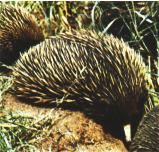The Echidna
 What animal has a beak
like a bird, spines like a hedgehog, eggs like a
reptile, lives as long as an elephant, and has a pouch like a kangaroo?
The answer is an Australian animal called the echidna. Echidnas are
small animals weighing no more than 5-10 pounds at maturity. They are
covered with spines that have sharp points at the ends, and they roll
up in a ball if they are threatened. The spines are actually modified
hairs and can be used to climb up or turn over rocks.
What animal has a beak
like a bird, spines like a hedgehog, eggs like a
reptile, lives as long as an elephant, and has a pouch like a kangaroo?
The answer is an Australian animal called the echidna. Echidnas are
small animals weighing no more than 5-10 pounds at maturity. They are
covered with spines that have sharp points at the ends, and they roll
up in a ball if they are threatened. The spines are actually modified
hairs and can be used to climb up or turn over rocks.
The echidna feeds on ants, termites, worms, grubs, and a variety of insects. They are excellent burrowers and can dig straight down, which most animals cannot do. Their body temperature is lower than most mammals--around 90°F. When a female is ready to mate, she will secrete a chemical called a pheromone. All males in the area will begin to follow her. They form a line and will follow her until she decides who her mate is to be. There will be a dozen males lined up following the female. They do not fight or abuse each other in any way. If one drops out, the others will close the gap. A new male will just join the train at the end. If the female goes up a tree, the males will make a circle around the tree and sometimes make a trench. It took many years before Australians finally realized what echidna circles were (and that they were not crop circles).
Echidnas are monotremes. Mono means one and what is being referred to is the fact that there is a single opening in the body for both excretion and reproduction. Once the female chooses a mate and is fertilized, there is a three-week gestation period. The female then lays an egg about the size of a dime in a pouch that has formed by a swelling of mammary glands and the pressure of the stomach muscle. This temporary pouch houses the egg for 10-11 days. When the egg hatches, the baby echidna called a puggle stays in the pouch to nurse. This baby is essentially an embryo--not a fully developed baby. It has no eyes backbone or hind legs. Its front legs are able to grasp to hang on, but it is not able to do much of anything except hold on and suck. In its first two weeks, it gains 30 grams, 100 times its birth weight. At seven to eight weeks, the baby starts growing spines, and the mother forces it out of her pouch and into a burrow in the ground. She feeds the baby every five or six days, but by the time the baby is seven months old, it is on its own.
Animals like the echidna are hard to study, but they seem to be an island in the world of mammals. They seem to be more like the platypus than any other form of life, but their uniqueness makes it very difficult to relate them to any other living form or to give a convincing evolutionary model for how they came to be as they are. They are just another wonderful example of the design and diversity that God has built into the world around us.
--Reference: National Wildlife, April/May, 2003, page 36R
Back to Contents Does God Exist?, MarApr04.